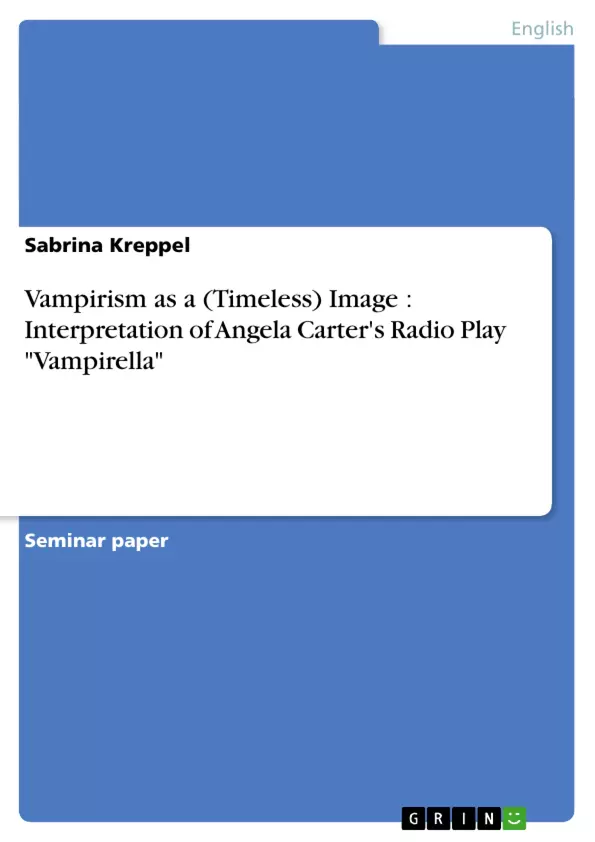Thinking about the success of the scaring black-and-white movies with the
famous vampire ‘Dracula’ in the 1950’s, the popularity of ‘The Small Vampire’
Rüdiger in the 1980’s or the effect of modern versions like ‘Interview with the
Vampire’ or ‘Buffy – the Vampire Slayer’ nowadays, it appears that people never
get enough from mystic, sometimes a little bit horrified stories about vampires,
wolves and werewolves, dark castles, everlasting life & beauty and more things,
which could neither be explained nor proved in reality.
The British prose author and feminist philosopher of English literature Angela
Carter (*1940 – 1992) knew the great fascination of folkloric material like fairy
tales and superstitious legends well; and she made it to one of her favourite
subjects of her literary work. With numerous, renewed fairy tales, novels, short
stories, plays and verses she satisfied peoples’ desire for gothic and surrealistic
stories diverting them from every-day-life. Due to the fact that the British
Broadcasting Corporation’s radio plays had flourished in Britain after the Second
World War and a lot of people enjoyed listening to them, Angela Carter paid
attention to this sub-genre of drama and wrote several radio plays, too.
Her first radio play Vampirella - broadcasted on 20th July 1976 in Radio 3 - was
born as such. Even a quick listening (or rather reading) of the radio play reveals,
that the serio-comedy Vampirella offers a lot of interesting aspects which cannot
be seen immediately, but should be recognised by all means. This interpretation
focuses on its peculiarities, which originate from the problematic theme of
Vampirism on the one hand and the composite art of the young medium radio on
the other hand. Moreover, it is a text-centred interpretation that analyses the text
and not the author’s intention or the individual impression.
Beginning with the obvious, the formal interpretation of structural features as
time, place, action and characters and the radiophonic elements, the analysis will
shift to the central themes and conflicts of the radio play. Above all the topic of
Vampirism as a (Timeless) Image will appear again and again.
Having been provided with various quotations from Vampirella it should be
possible to get a sense of Angela Carter’s unmistakable style and to imagine the
female-interpreted story in mind, although the real radio listening experience is
missing.
Inhaltsverzeichnis (Table of Contents)
- Introduction
- Outer Structure
- Main Structural Features
- Time
- Place
- Action
- Characters
- Radiophonic Elements
- Words and Voices
- Non-verbal Utterances, Pauses and Silences
- Music and Sound Effects proper
- Technological Features
- Main Structural Features
- Central Themes & Conflicts
- Introductory: Vampirella vs. Cinderella
- The Radio Play as a Serio-Comedy
- The Meaning of Love and Redemption
- Vampirism as a (Timeless) Image
- Conclusion
Zielsetzung und Themenschwerpunkte (Objectives and Key Themes)
This interpretation of Angela Carter's radio play "Vampirella" aims to explore the peculiarities of the work, particularly the themes of Vampirism and the unique artistic qualities of radio as a medium. The analysis will focus on the text itself and not on the author's intent or individual impressions.
- The use of Vampirism as a timeless image in the context of the radio play.
- The unique characteristics of the radio play genre and its impact on the text.
- The interplay of structural features, radiophonic elements, and thematic conflicts within "Vampirella."
- The exploration of love and redemption within the context of the Vampirella narrative.
- The serio-comedy aspects of the radio play and their contributions to the overall meaning.
Zusammenfassung der Kapitel (Chapter Summaries)
The Introduction provides a broad context for the analysis, outlining the enduring fascination with vampire narratives and introducing Angela Carter as a significant figure in this tradition. The analysis then shifts to the Outer Structure of the radio play, examining the key structural features of time, place, action, and characters. It also explores the unique elements of radio drama, such as words and voices, non-verbal utterances, music, and sound effects.
The chapter on Central Themes & Conflicts delves into the interplay between various elements, including the comparison of Vampirella to Cinderella, the radio play's serio-comedy elements, and the exploration of love and redemption. It concludes with an examination of the central theme of Vampirism as a timeless image.
Schlüsselwörter (Keywords)
The key terms and concepts explored in this interpretation include: Vampirism, radio play, structural features, radiophonic elements, serio-comedy, love, redemption, timeless image, Angela Carter, Vampirella, British Broadcasting Corporation (BBC), and folklore.
- Arbeit zitieren
- Sabrina Kreppel (Autor:in), 2002, Vampirism as a (Timeless) Image : Interpretation of Angela Carter's Radio Play "Vampirella", München, GRIN Verlag, https://www.grin.com/document/17254



